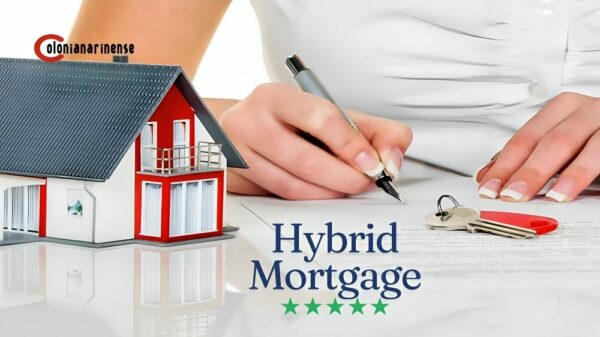A hybrid mortgage is a versatile loan option that combines features of both fixed-rate and adjustable-rate mortgages (ARMs), offering borrowers the stability of a fixed rate for an initial period and the flexibility of a variable rate thereafter. This structure can be appealing for homeowners who want the predictability of fixed payments at first, along with the potential for lower rates in the future.
While hybrid mortgages offer attractive advantages, such as lower initial payments and rate caps, they also come with risks that borrowers should carefully consider before making a decision.
What is a Hybrid Mortgage?
A hybrid mortgage—also known as a combination or step mortgage—is a type of adjustable-rate mortgage that starts with a fixed interest rate for a set period. After this fixed period ends, the loan switches to a variable rate for the remainder of the term. Commonly, a hybrid mortgage is expressed as “5/1,” “7/1,” or “10/1,” where the first number indicates the fixed-rate period in years, and the second number represents the frequency of rate adjustments thereafter.
How Hybrid Mortgages Work
Hybrid mortgages are based on an index and margin system. The index is a benchmark interest rate that fluctuates with the economy, and the margin is a set percentage added by the lender to determine the final rate. Common indices include LIBOR (London Interbank Offered Rate) and the Cost of Funds Index (COFI). Once the initial fixed-rate period is over, the mortgage rate will adjust according to changes in the index, potentially altering monthly payments.
Rate Caps are another critical component of hybrid mortgages. These caps limit the extent of interest rate increases:
- Initial Adjustment Cap: Limits the rate increase at the first adjustment after the fixed-rate period.
- Subsequent Adjustment Cap: Sets a maximum increase for each following adjustment.
- Lifetime Adjustment Cap: Restricts the maximum rate increase over the loan’s entire term.
Rate caps help protect borrowers from extreme fluctuations, though adjustments still introduce a level of unpredictability.
Pros and Cons of a Hybrid Mortgage
| Pros | Cons | Explanation |
| Lower Initial Rates | Rate Uncertainty After Fixed Period | Hybrid mortgages often start with lower rates than fixed-rate loans, making them affordable initially but uncertain after the fixed period ends. |
| Potential Savings | Potential for Higher Payments Later | If rates stay low, monthly payments remain affordable; however, rising rates could lead to significantly higher payments down the line. |
| Flexibility for Short-Term Needs | Complexity of Loan Terms | Hybrid mortgages offer stability at first, making them suitable for short-term stays, but complex terms can add confusion for long-term planning. |
| Rate Caps for Protection | Payment Shock Risk | Rate caps prevent drastic increases but can still allow substantial changes, which may lead to “payment shock” if rates spike after the fixed period. |
| Easier Qualification | Possible Refinancing Costs | Lower initial rates can ease qualification, but refinancing into a fixed-rate mortgage later may incur additional costs if the rate structure changes. |
Is a Hybrid Mortgage Right for You?
A hybrid mortgage can be beneficial if you’re looking for an affordable initial payment and are open to potential rate adjustments down the line. It’s also an option to consider if you plan to refinance before the adjustable period begins, giving you a short-term cost-saving advantage. However, understanding economic trends and rate forecasts is essential, as these will influence your payments in the future.
FAQs about Hybrid Mortgages
What is a hybrid mortgage, and how does it differ from other mortgages?
A hybrid mortgage is a loan with an initial fixed interest rate that transitions to a variable rate after a set period. Unlike a standard fixed-rate mortgage, it combines both fixed and adjustable features, offering initial payment stability followed by potential rate fluctuations.
What are common types of hybrid mortgages?
Common types include 3/1, 5/1, 7/1, and 10/1 hybrids. For instance, in a 5/1 mortgage, the interest rate is fixed for five years and then adjusts annually. These formats vary based on the initial fixed period and subsequent adjustment frequency.
What are the advantages of a hybrid mortgage?
Hybrid mortgages offer lower initial rates and payments, flexibility for short-term financial planning, and rate caps to limit potential increases. They can be a good choice for borrowers expecting to sell or refinance within the initial fixed period.
What are the risks associated with hybrid mortgages?
The primary risk is rate uncertainty after the fixed period. Payments may rise significantly if market rates increase, leading to higher monthly costs. This uncertainty may not suit those seeking long-term payment stability.
Can I refinance a hybrid mortgage into a fixed-rate mortgage?
Yes, refinancing to a fixed-rate mortgage is an option if you want more predictability after the fixed period ends. Eligibility depends on factors such as your credit score, loan-to-value ratio, and market conditions at the time of refinancing.



